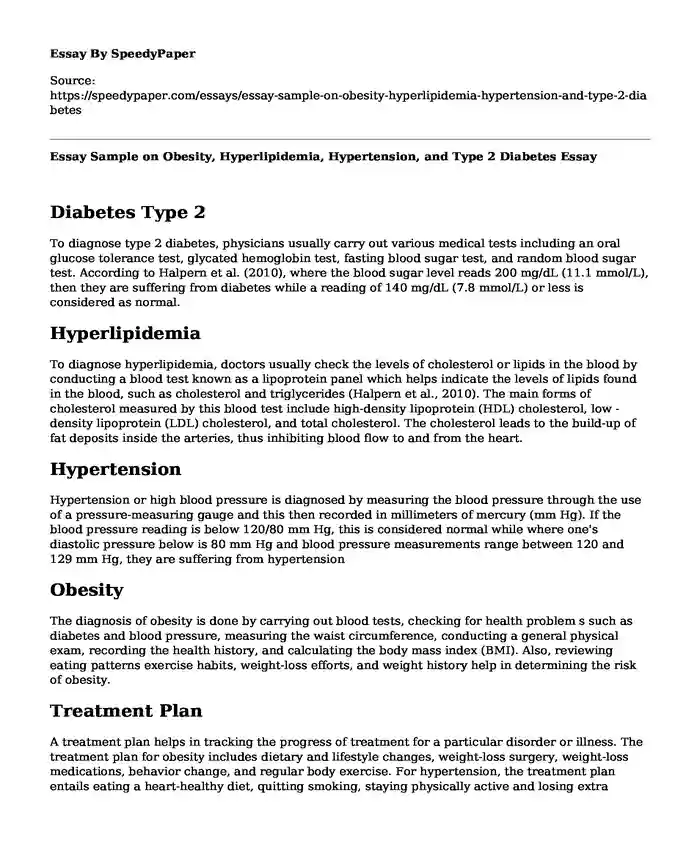
| Type of paper: | Essay |
| Categories: | Healthcare Diabetes |
| Pages: | 3 |
| Wordcount: | 698 words |
Diabetes Type 2
To diagnose type 2 diabetes, physicians usually carry out various medical tests including an oral glucose tolerance test, glycated hemoglobin test, fasting blood sugar test, and random blood sugar test. According to Halpern et al. (2010), where the blood sugar level reads 200 mg/dL (11.1 mmol/L), then they are suffering from diabetes while a reading of 140 mg/dL (7.8 mmol/L) or less is considered as normal.
Hyperlipidemia
To diagnose hyperlipidemia, doctors usually check the levels of cholesterol or lipids in the blood by conducting a blood test known as a lipoprotein panel which helps indicate the levels of lipids found in the blood, such as cholesterol and triglycerides (Halpern et al., 2010). The main forms of cholesterol measured by this blood test include high-density lipoprotein (HDL) cholesterol, low -density lipoprotein (LDL) cholesterol, and total cholesterol. The cholesterol leads to the build-up of fat deposits inside the arteries, thus inhibiting blood flow to and from the heart.
Hypertension
Hypertension or high blood pressure is diagnosed by measuring the blood pressure through the use of a pressure-measuring gauge and this then recorded in millimeters of mercury (mm Hg). If the blood pressure reading is below 120/80 mm Hg, this is considered normal while where one's diastolic pressure below is 80 mm Hg and blood pressure measurements range between 120 and 129 mm Hg, they are suffering from hypertension
Obesity
The diagnosis of obesity is done by carrying out blood tests, checking for health problem s such as diabetes and blood pressure, measuring the waist circumference, conducting a general physical exam, recording the health history, and calculating the body mass index (BMI). Also, reviewing eating patterns exercise habits, weight-loss efforts, and weight history help in determining the risk of obesity.
Treatment Plan
A treatment plan helps in tracking the progress of treatment for a particular disorder or illness. The treatment plan for obesity includes dietary and lifestyle changes, weight-loss surgery, weight-loss medications, behavior change, and regular body exercise. For hypertension, the treatment plan entails eating a heart-healthy diet, quitting smoking, staying physically active and losing extra weight, and eating omega-3 rich foods such as salmon and cutting down on trans-fat intake (Halpern et al., 2010). Further, the treatment plan for hyperlipidemia includes lifestyle changes such as exercise, weight loss, and eating a healthy diet while that for type 2 diabetes mainly consists of blood sugar monitoring, insulin therapy and diabetes medication, regular exercise, and healthy eating.
Health Promotion
Health promotion refers to the practice through which individuals and communities are enabled to improve and have more control over their health and healthcare decision-making by focusing on individual behavior, attitudes, and factors that either negate or promote healthy living among populations (Labarthe & Dunbar, 2012). It is particularly important for preventing disorders such as diabetes type 2, hyperlipidemia, hypertension, and obesity since it increases people's knowledge and ability to adopt healthy lifestyles and behaviors. Therefore, health promotion among those with cardiovascular and metabolic disorders, for instance, should emphasize on educating people on healthy living, healthy diets, physical activity such as exercises, avoiding fast foods, intake of medications, avoidance of smoking, and living active rather than sedentary lifestyles,
Disease Prevention
Disease prevention refers to those measures, interventions, or procedures for treating individuals for various conditions to reduce the burdens of diseases and other risk factors associated with them. Such preventive actions include early detection, diagnosis, and treatment of signs and symptoms so as to prevent the full-blown disease. For example, to prevent diseases as obesity, hyperlipidemia, hypertension, and type 2 diabetes individuals should be educated on ways of living healthy lifestyles, adopting healthy behaviors, staying active, and eating healthy diets. Further, according to Padawal and Sharma (2010), prevention programs that target the at-risk population can help prevent diseases such as diabetes and obesity.
References
Halpern, A., Mancini, M.C., Magalhaes, M.E., Fisberg, M., Radominski, R., Bertolami, M.C., Bertolami, A.... & Nery, M. (2010). Metabolic syndrome, dyslipidemia, hypertension and type 2 diabetes in youth: From diagnosis to treatment. Diabetology & Metabolic Syndrome, 2, 55, 1-20
Labarthe, D.R., & Dunbar, S.B. (2012). Global cardiovascular health promotion and disease prevention: 2011 and beyond. Circulation, 125 (21), 2667-2676
Padwal, P.S., & Sharma, A.M. (2010). Prevention of cardiovascular disease: Obesity, diabetes, and metabolic syndrome. The Canadian Journal of Cardiology, 26, 18-30
Cite this page
Essay Sample on Obesity, Hyperlipidemia, Hypertension, and Type 2 Diabetes. (2022, Oct 12). Retrieved from https://speedypaper.net/essays/essay-sample-on-obesity-hyperlipidemia-hypertension-and-type-2-diabetes
Request Removal
If you are the original author of this essay and no longer wish to have it published on the SpeedyPaper website, please click below to request its removal:
- Essay Example: Domestic Violence Case Study
- Free Essay with Discussion Forum Responses
- Inconsistencies and Tensions of Marxism and Communism, Essay Example
- Creative Writing Essay Example on Images as Inspiration: The Skat Players
- Free Essay Analyzing the Parable of the Good Samaritan
- Essay Sample on Special Education Teacher Recruitment
- Free Essay: Woman Suffrage Movement and the Nineteenth Amendment
Popular categories




